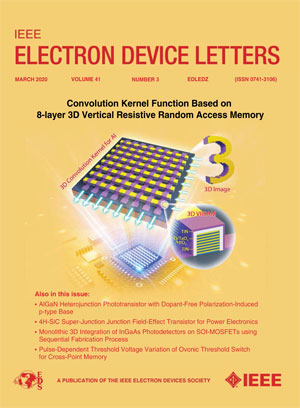Efficient Red Sn-Based Perovskite Light Emitting Diodes by a Competitive Antioxidation Strategy
IF 4.1
2区 工程技术
Q2 ENGINEERING, ELECTRICAL & ELECTRONIC
引用次数: 0
Abstract
Tin (Sn)-based perovskite light-emitting diodes (PeLEDs) have emerged as a promising candidate for next-generation displays because of their eco-friendliness, exceptional optoelectronic properties, and cost-effective solution processability. However, their electroluminescence performance still lags behind their lead (Pb) counterparts, primarily due to the undesired Sn2+ oxidation to Sn4+ and the rapid crystallization of Sn-based perovskite, resulting in high defect density as well as poor film quality. Herein, we reported a competitive antioxidation strategy by utilizing a phosphorus ylide, namely (triphenylphosphoranilidene) acetaldehyde (TPPA), to suppress the oxidation of Sn2+ and regulate the growth kinetics, simultaneously. The TPPA with highly active polar phosphorus-carbon bonds can be oxidized prior to Sn2+, and their large steric hindrance can slow down the crystallization process of tin-based perovskite. Moreover, the main product from the oxidation reaction, namely triphenylphosphine oxide (TPPO), can further passivate defects by coordinating with SnI6 octahedra. The resulting Sn-based perovskite film exhibits enhanced optical properties and uniform, dense morphology. Leveraging these improvements, the optimized PeLED delivers pure-red light emission with Commission Internationale de L’Eclairage (CIE) color coordinates of (0.69, 0.30), an external quantum efficiency (EQE) of 8.1% and maximum luminance of 672 cd m−2. This work provides a facile route to enhance the overall performance of Sn-based PeLEDs.基于竞争抗氧化策略的高效红色锡基钙钛矿发光二极管
锡(Sn)基钙钛矿发光二极管(PeLEDs)因其生态友好、卓越的光电性能和具有成本效益的解决方案可加工性而成为下一代显示器的有希望的候选者。然而,它们的电致发光性能仍然落后于铅(Pb),主要是由于不希望Sn2+氧化成Sn4+和sn基钙钛矿的快速结晶,导致缺陷密度高,薄膜质量差。在此,我们报道了一种竞争性抗氧化策略,即利用磷酰化物(三苯基磷苯胺)乙醛(TPPA)来抑制Sn2+的氧化,同时调节生长动力学。具有高活性极性磷碳键的TPPA可以先于Sn2+被氧化,其较大的位阻可以减缓锡基钙钛矿的结晶过程。此外,氧化反应的主要产物氧化三苯基膦(TPPO)可以通过与SnI6八面体配合进一步钝化缺陷。所得的锡基钙钛矿薄膜具有增强的光学性能和均匀致密的形貌。利用这些改进,优化后的PeLED提供纯红光发射,国际照明委员会(CIE)色坐标为(0.69,0.30),外部量子效率(EQE)为8.1%,最大亮度为672 cd m−2。这项工作为提高锡基ped的整体性能提供了一条简便的途径。
本文章由计算机程序翻译,如有差异,请以英文原文为准。
求助全文
约1分钟内获得全文
求助全文
来源期刊

IEEE Electron Device Letters
工程技术-工程:电子与电气
CiteScore
8.20
自引率
10.20%
发文量
551
审稿时长
1.4 months
期刊介绍:
IEEE Electron Device Letters publishes original and significant contributions relating to the theory, modeling, design, performance and reliability of electron and ion integrated circuit devices and interconnects, involving insulators, metals, organic materials, micro-plasmas, semiconductors, quantum-effect structures, vacuum devices, and emerging materials with applications in bioelectronics, biomedical electronics, computation, communications, displays, microelectromechanics, imaging, micro-actuators, nanoelectronics, optoelectronics, photovoltaics, power ICs and micro-sensors.
 求助内容:
求助内容: 应助结果提醒方式:
应助结果提醒方式:


